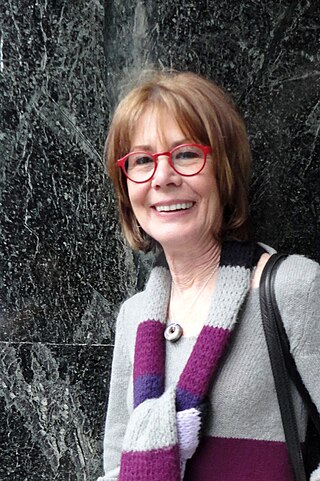
Kelly Richardson is a Canadian artist and stuntwoman working with digital technologies to create hyper-real landscapes. She is currently a professor at the Department of Visual Arts of the University of Victoria.
Jan Peacock is a Canadian interdisciplinary artist, curator and writer.

Rebecca Belmore D.F.A. is an interdisciplinary Anishinaabekwe artist who is notable for politically conscious and socially aware performance and installation work. She is Ojibwe and member of Obishikokaang. Belmore currently lives in Toronto, Ontario.

Alex Simeon Janvier, LL.D is a First Nation artist in Canada. As a member of the commonly referred to "Indian Group of Seven", Janvier is a pioneer of contemporary Canadian Aboriginal art in Canada.

Suzy Lake is an American-Canadian artist based in Toronto, Canada, who is known for her work as a photographer, performance artist and video producer. Using a range of media, Lake explores topics including identity, beauty, gender and aging. She is regarded as a pioneering feminist artist and a staunch political activist.
Shary Boyle D.F.A. is a contemporary Canadian visual artist working in the mediums of sculpture, drawing, painting and performance art. She lives and works in Toronto.
Ron Terada is a Vancouver-based artist working in various media, including painting, photography, video, sound, books, and graphic design.
Stephen Andrews is a Canadian artist based in Toronto. Born in 1956 in Sarnia, Ontario, Andrews is known for using various media to explore matters such as memory and loss, and technology, and its representations.
Ursula Johnson is a multidisciplinary Mi’kmaq artist based in Halifax, Nova Scotia, Canada. Her work combines the Mi’kmaq tradition of basket weaving with sculpture, installation, and performance art. In all its manifestations her work operates as didactic intervention, seeking to both confront and educate her viewers about issues of identity, colonial history, tradition, and cultural practice. In 2017, she won the Sobey Art Award.
Susan McEachern is an American/Canadian artist. McEachern is best known for her photography, which frequently includes text. Her work follows the feminist idea of "the personal is political," as she often combines images of her own life and personal space to investigate and comment on themes of socialization, gender, sexuality, and the natural world. McEachern has also been a professor at the Nova Scotia College of Art and Design University since 1979.
Carol Wainio is a Canadian painter. Her work, known for its visual complexity and monochrome color palette, has been exhibited in major art galleries in Canada, the U.S., Europe and China. She has won multiple awards, including the Governor General's Award in Visual and Media Arts.
Monica Tap is a Canadian painter, artist and educator. She lives in Toronto, Ontario, and teaches at the University of Guelph. She is known for engaging and challenging conventions concerning landscape and still-life painting.

Peggy Gale is an independent Canadian curator, writer, and editor. Gale studied Art History and received her Honours Bachelor of Arts degree in Art History from the University of Toronto in 1967. Gale has published extensively on time-based works by contemporary artists in numerous magazines and exhibition catalogues. She was editor of Artists Talk 1969-1977, from The Press of the Nova Scotia College of Art and Design, Halifax (2004) and in 2006, she was awarded the Governor General's Award in Visual and Media Arts. Gale was the co-curator for Archival Dialogues: Reading the Black Star Collection in 2012 and later for the Biennale de Montréal 2014, L’avenir , at the Musée d’art contemporain de Montréal. Gale is a member of IKT, AICA, The Writers' Union of Canada, and has been a contributing editor of Canadian Art since 1986.
Nell Tenhaaf is a Canadian artist, teacher, writer and feminist.

Gu Xiong is a Canadian contemporary artist.
Nancy Tousley is a senior art critic, journalist, art writer and independent curator whose practice has included writing for a major daily newspaper, art magazines, and exhibition catalogues.
Zainub Verjee DFA LL. D. is a Kenya-born Canadian video artist, curator, writer, arts administrator and public intellectual. She began her career in the Vancouver arts community of the 1970s, which was steeped in interdisciplinary, intermedia, and intercultural practices. Having made her mark as an emerging artist, she shifted the emphasis of her work to curatorial, administrative and policy arenas. Applying the insight, creativity and criticality of an artist, she has brought “institutional critique” into the workings of the institution itself. Deeply engaged with the UK’s British Black Arts, Tactical Video Movement, Third Cinema and the post-Bandung Conference decolonization, Verjee has been embedded in the history of women’s labour in British Columbia. In February 2020 she was awarded the 2020 Governor General’s Award in Visual and Media Arts for “outstanding contribution to the arts”. In 2021 she was conferred an honorary doctorate by the OCAD University recognizing her outstanding contribution to arts, racial and gender equity She was elected as a Senior Fellow of the Massey College at University of Toronto in the Fall of 2021. Earlier she was appointed as McLaughlin College Fellow at the York University. In 2022 she was conferred Doctor of Fine Arts, honours causa, by Nova Scotia College of Art and Design NSCAD University, Halifax
Judith Berry is a Canadian painter.
Elisabeth Belliveau is a Canadian interdisciplinary artist and author of four graphic novels. Currently based in Treaty Six Territory, Amiskwaciwâskahikan, Edmonton, Alberta, she is an Assistant Professor of Fine Arts at Grant MacEwan University Faculty of Fine Arts and Communications. She previously taught at the Grande Prairie Regional College in Alberta, and at Concordia University in Montreal.
Laura Millard is a Canadian contemporary artist. She uses for her installations drawings and videos records of the marks left on the earth obtained from drones, such as traces of the tracks of skates and snowmobiles on ice in northern Canada in a long-term investigation of ways to reinvent the landscape tradition of Canada. She also is an educator with over many years of experience working at OCAD University and a writer; she lives and works in Toronto.







